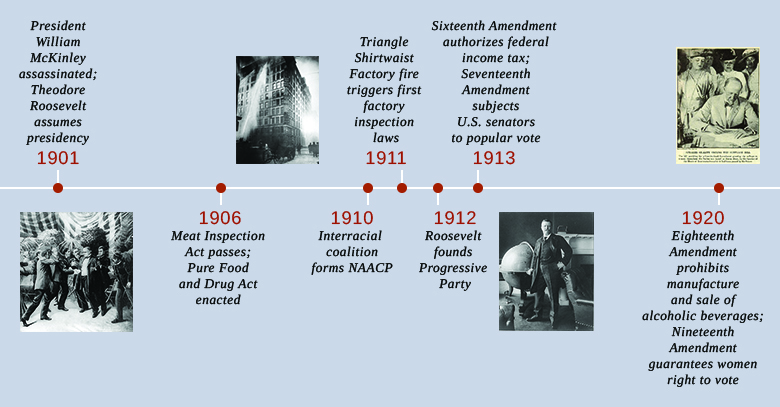Chapter 21: Leading the Way: The Progressive Movement, 1890-1920
The Origins of the Progressive Spirit in America
Learning Objectives
By the end of this section, you will be able to:
- Describe the role that muckrakers played in catalyzing the Progressive Era
- Explain the main features of Progressivism
The Progressive Era was a time of wide-ranging causes and varied movements, where activists and reformers from diverse backgrounds and with very different agendas pursued their goals of a better America. These reformers were reacting to the challenges that faced the country at the end of the nineteenth century: rapid urban sprawl, immigration, corruption, industrial working conditions, the growth of large corporations, women’s rights, and surging anti-black violence and white supremacy in the South. Investigative journalists of the day uncovered social inequality and encouraged Americans to take action. The campaigns of the Progressives were often grassroots in their origin. While different causes shared some underlying elements, each movement largely focused on its own goals, be it the right of women to vote, the removal of alcohol from communities, or the desire for a more democratic voting process.

THE MUCKRAKERS
A group of journalists and writers collectively known as muckrakers provided an important spark that ignited the Progressive movement. Unlike the “yellow journalists” who were interested only in sensationalized articles designed to sell newspapers, muckrakers exposed problems in American society and urged the public to identify solutions. Whether those problems were associated with corrupt machine politics, poor working conditions in factories, or the questionable living conditions of the working class (among others), muckrakers shined a light on the problem and provoked outraged responses from Americans. President Theodore Roosevelt knew many of these investigative journalists well and considered himself a Progressive. Yet, unhappy with the way they forced agendas into national politics, he was the one who first gave them the disparaging nickname “muckrakers,” invoking an ill-spirited character obsessed with filth from The Pilgrim’s Progress, a 1678 Christian allegory written by John Bunyan.
Beginning in the second half of the nineteenth century, these Progressive journalists sought to expose critical social problems and exhort the public to take action. In his book, How the Other Half Lives (1890), journalist and photographer Jacob Riis used photojournalism to capture the dismal and dangerous living conditions in working-class tenements in New York City (Figure 21.3). Ida Tarbell, perhaps the most well-known female muckraker, wrote a series of articles on the dangers of John D. Rockefeller’s powerful monopoly, Standard Oil. Her articles followed Henry Demarest Lloyd’s book, Wealth Against Commonwealth, published in 1894, which examined the excesses of Standard Oil. Other writers, like Lincoln Steffens, explored corruption in city politics, or, like Ray Standard Baker, researched unsafe working conditions and low pay in the coal mines.

The work of the muckrakers not only revealed serious problems in American society, but also agitated, often successfully, for change. Their articles, in magazines such as McClure’s, as well as books garnered attention for issues such as child labor, anti-trust, big business break-ups, and health and safety. Progressive activists took up these causes and lobbied for legislation to address some of the ills troubling industrial America.
Click and Explore
To learn more about one of the most influential muckrakers of the late nineteenth century, peruse the photographs, writings, and more at the Ida M. Tarbell archives that are housed at Tarbell’s alma mater, Allegheny College, where she matriculated in 1876 as the only woman in her class.
THE FEATURES OF PROGRESSIVISM
Muckrakers drew public attention to some of the most glaring inequities and scandals that grew out of the social ills of the Gilded Age and the hands-off approach of the federal government since the end of Reconstruction. These writers by and large addressed a white, middle-class and elite, native-born audience, even though Progressive movements and organizations involved a diverse range of Americans. What united these Progressives beyond their different backgrounds and causes was a set of uniting principles, however. Most strove for a perfection of democracy, which required the expansion of suffrage to worthy citizens and the restriction of political participation for those considered “unfit” on account of health, education, or race. Progressives also agreed that democracy had to be balanced with an emphasis on efficiency, a reliance on science and technology, and deference to the expertise of professionals. They repudiated party politics but looked to government to regulate the modern market economy. And they saw themselves as the agents of social justice and reform, as well as the stewards and guides of workers and the urban poor. Often, reformers’ convictions and faith in their own expertise led them to dismiss the voices of the very people they sought to help.
The expressions of these Progressive principles developed at the grassroots level. It was not until Theodore Roosevelt unexpectedly became president in 1901 that the federal government would engage in Progressive reforms. Before then, Progressivism was work done by the people, for the people. What knit Progressives together was the feeling that the country was moving at a dangerous pace in a dangerous direction and required the efforts of everyday Americans to help put it back on track.

